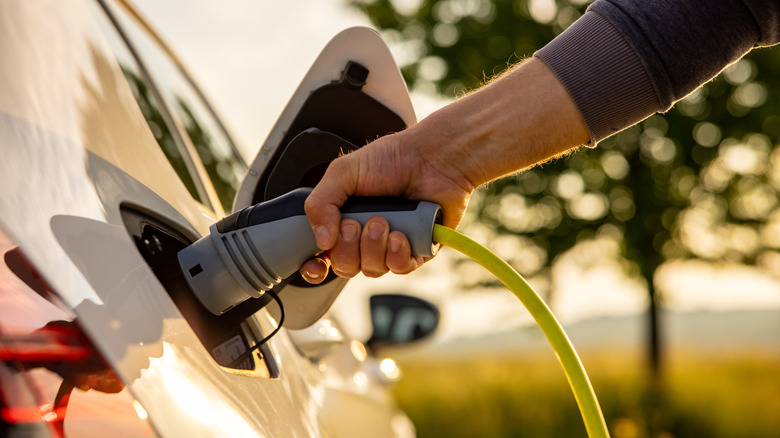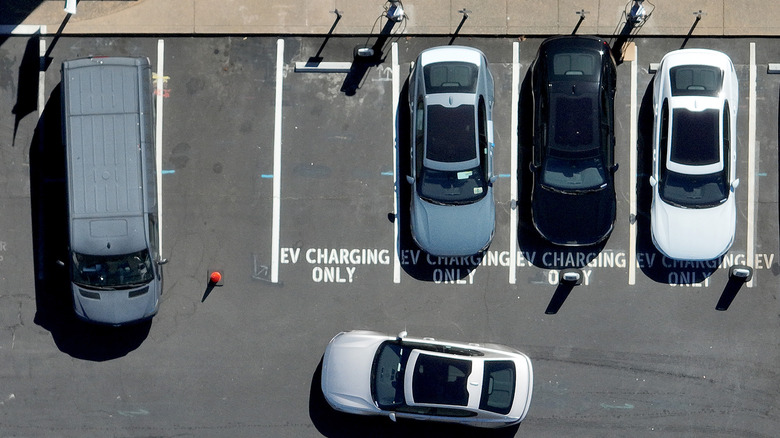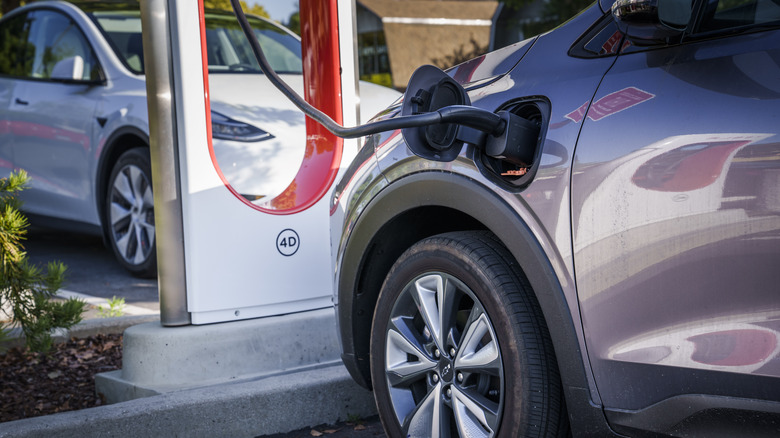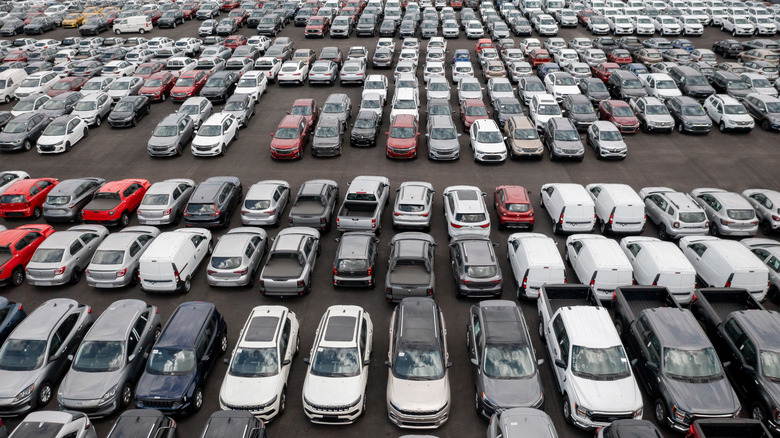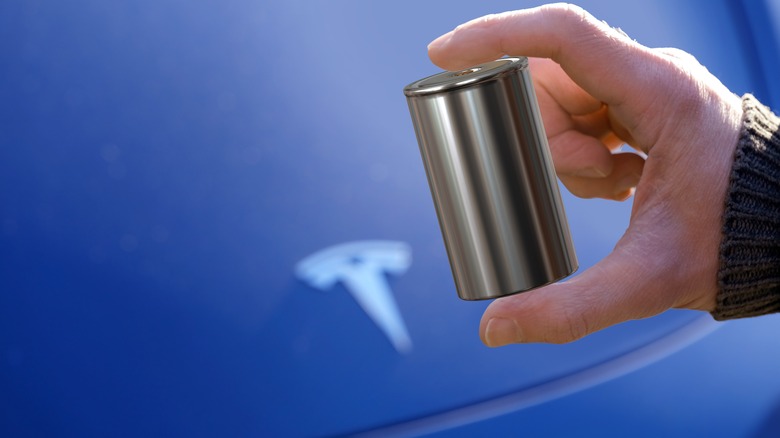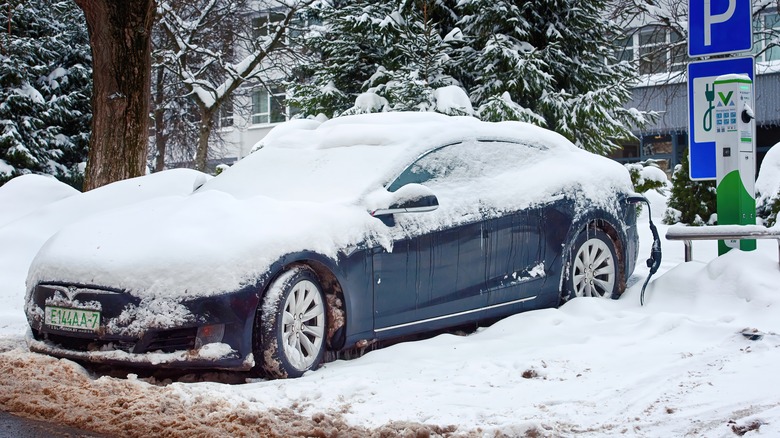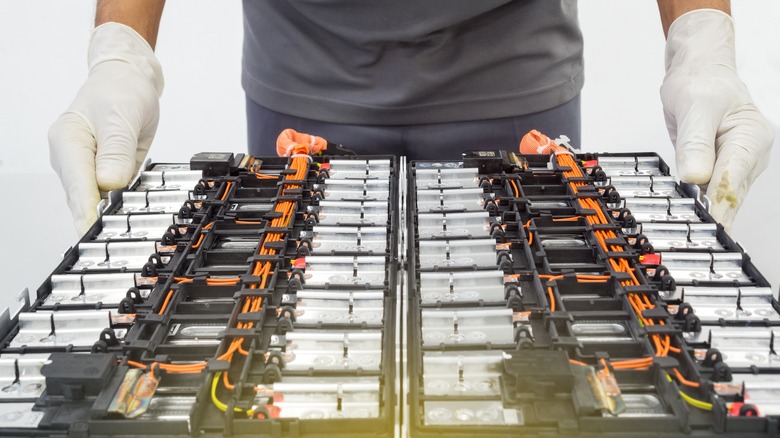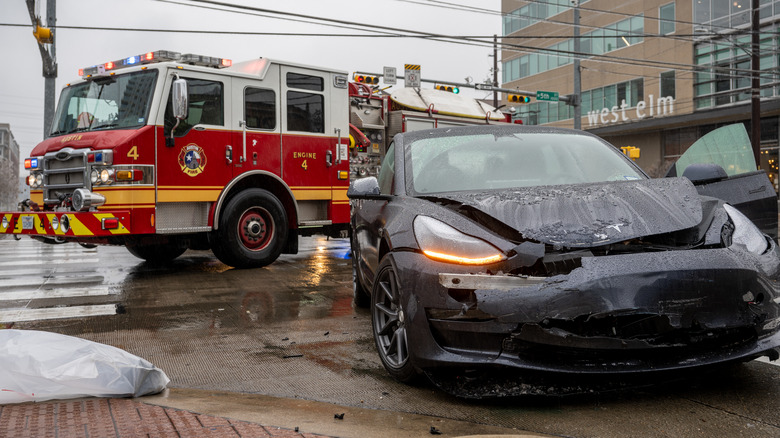The Biggest Problems With Electric Cars That Still Haven't Been Solved
There's arguably never been a better time to buy an electric car. Most major manufacturers now have at least one EV in their lineup, with many more on the way soon. The days of laughable double-digit ranges are long gone, and the longest-range EVs on the market can now travel as far as most gas-powered cars without needing to charge. There's a long list of things that EVs are better at than their combustion-engined counterparts, and the best electric cars on the market span every major segment from pickups to luxury sedans.
However, just because EV technology is rapidly advancing doesn't mean it's without its flaws. Electric vehicle adoption in the U.S. remains relatively low, and for a good reason — many of the biggest remaining problems are considered deal breakers by buyers and will need to be fully remedied before EVs become the default option for most people. The trouble is, solutions for these problems are not always straightforward, taking years of work and potentially billions of dollars to fix, and that's if they can be fixed at all.
Here are the most important issues that EV designers are still working to solve.
Lack of charging infrastructure
Perhaps the biggest hurdle facing the EV industry is the lack of accessible charging infrastructure available to drivers. America has had over 100 years to develop its network of gas stations, but if EVs are to become widely adopted, an equally comprehensive EV charging network needs to be developed within the space of the next decade. The government does recognize this, and in 2022, Congress passed a bill to fund 500,000 new electric vehicle chargers, with a focus on delivering infrastructure to more remote, rural parts of the country.
However, the current network of chargers means that owning an all-electric vehicle simply isn't feasible for many people outside of major towns and cities. Even within built-up areas, owners without access to a driveway to charge their car face the prospect of relying on the sometimes unreliable private charger network. Until those issues are fixed and electric car charging becomes just as easy as filling up a car at a gas station, many Americans are likely to remain hesitant to make the switch to electric power.
Range anxiety
A closely related problem to the insufficient charging infrastructure is range anxiety. Even though the longest-range EVs today can travel more than 300 miles on a single charge, a patchy charging network and the sometimes inconsistent range indicators on EVs can make longer trips a stressful experience. Most people, understandably, would rather not add any extra stress to their everyday lives and choose to dismiss buying an electric car altogether as a result.
As infrastructure improves and ranges continue to increase, it's likely that range anxiety will become less of an issue, but for now, it remains one of the key hurdles stopping wider EV adoption. It's one thing telling people that data shows most EV owners never come close to running out of charge, but it's another thing entirely trying to stop them from worrying about it in the first place.
The solution, however, is already underway — invest in more charging stations and longer-range battery technology. Still, it will take years and billions of dollars yet before those investments make range anxiety a thing of the past.
Charging speeds
Even if EV chargers end up becoming as ubiquitous as gas stations, there's still the issue of the amount of time it takes to fully charge a car. A range of chargers are available for both home and public charging, with the fastest of those being able to deliver over 100 miles of range in 10-20 minutes, but that's still significantly slower than a gas station stop. Those top-spec Level 3 chargers can't be installed at home either. To make matters worse, not every EV supports the same level of fast charging, so depending on the model of your car, you might not be able to make use of those higher-speed chargers even if you have one nearby.
Charging at a public charging station is not always a straightforward experience either –- each charging network will usually require its own app to pay for a charge, so if you rely on multiple different brands in your city, you might need several apps to be able to use every station.
Ensuring that's all correctly set up adds extra time and complexity, making for a much more time-consuming experience than pulling into a gas station and simply filling up the tank.
Affordability
Despite a downward trend in recent months, EVs still remain, on average, more expensive to buy than gas cars, and that's a big issue for buyers on a tighter budget.
According to Kelley Blue Book, the average new car in the U.S. sold for $49,507 in December 2022, while the average new EV cost $61,448. Supply chain shortages and pandemic-related delays saw average new car prices soar over the past few years, forcing some buyers out of the market altogether and others to accept longer-term finance deals in a bid to keep monthly payments manageable.
It's no secret that, in the face of restrictions on the number of cars it could produce, the auto industry prioritized models with higher profit margins, often introducing prohibitively long wait times for cheaper cars. The news that EVs add an extra premium to the inflated market will do little to reassure buyers already stretching their finances to afford a new car.
Battery degradation
Another key factor for buyers to consider when purchasing a car is how long they expect it to last. Modern cars now last longer on average than ever before, largely due to improvements in materials and the manufacturing process over time. However, EVs also feature an extra variable that, for now, remains largely unknown: how much the battery will degrade over the years it's on the road. Most of the current data we have to examine degradation comes from Tesla, and it seems promising –- on average, the brand claimed its battery lost only 12% of its capacity over 200,000 miles.
However, data from other manufacturers is extremely limited or non-existent. A study by UK-based Autocar claimed certain models could reach problematic levels of degradation in less than a decade, with batteries degrading more rapidly once they lose 30% capacity. This, in turn, could make older EVs effectively unsellable, especially those with lower ranges from the factory to begin with.
Predicting how long an EV will last before it degrades significantly is far from an exact science with so little data available. Unfortunately for current EV owners, their cars will form the basis of the dataset that future estimates will be calculated.
Dealing with extreme temperatures
With extreme temperatures becoming more common in the face of climate change, another flaw EVs face is that they generally don't cope very well with colder climates. In fact, temperature can affect range significantly, with the average range dropping by 41% at 20°F compared to 77°F, according to the Department of Energy. In comparison, a gas car only loses 15% of its range on average. A 41% drop in range is a deal breaker for many people, especially in places where such temperatures are expected throughout significant parts of the winter months.
Not only that, but a study by the Idaho National Laboratory found that charging times were much slower in cold weather too. A 30-minute charge with a DCFC fast charger saw researchers achieve an 80% charge at 77°F, but at 32°F, they only recorded 44% charge.
There's no obvious solution to these issues for now, but EV manufacturers will have to address them in the immediate future if they have any hope of convincing northern buyers that it's worth the switch to electric.
Coal and gas power stations
The biggest reason for the push towards electric cars is that they are, in theory, a cleaner form of transport than gas-powered cars. Electric vehicles produce no emissions at the tailpipe, but to look at them in isolation is to miss the bigger picture.
According to the U.S. Energy Information Administration, natural gas was the biggest source of electricity generation in 2022, at around 40%, while coal-fired power stations produced around 18% of electricity. Nuclear power was the second biggest source, and while it doesn't produce emissions in the same way, nuclear waste has its own negative environmental impacts.
Renewable energy only made up about 22% of electricity generation, meaning that the majority of electricity powering EVs was still generated through the use of non-renewable resources. An analysis by the Department of Energy claimed that total renewable energy resources in America could produce 100 times the nation's annual need, but only a tiny fraction of those resources have been used so far. Until more renewables are in place, EVs will continue to run indirectly on gas and coal power thanks to the nation's aging power infrastructure.
Environmental impact of mining
Two key elements needed in the manufacture of EV batteries are lithium and cobalt, with mines being dug across the globe in response to the rapidly increasing demand for both commodities. Lithium mining is concentrated primarily in China and parts of South America, but several recent discoveries of deposits in India and in the Rhine River Valley in Germany mean that more mines are likely to open soon.
A recently published study led by scientists at the University of Western Australia called lithium an "emerging environmental contaminant," noting that increasing levels of lithium contamination were beginning to be found both in plants and organisms, although the potential effects remain largely unknown for now. Likewise, cobalt-contaminated soil is known to pose a risk to humans, with processes to decontaminate the soil still needing further development.
As global demand for EVs increases, these environmental impacts are likely to become even more pronounced.
Battery disposal and recycling
EVs are now selling in larger numbers than ever, which means that, in 10 to 15 years, there will be a slew of EV batteries reaching the end of their usable lives. There's no easy way to recycle the current generation of lithium-ion batteries, and although several startups are developing ways to reuse the materials within them, they remain fairly small-scale operations for now.
A key issue is that current EV batteries aren't designed to be recycled in the first place –- in a bid to make the manufacturing process as easy and cost-effective as possible, many batteries are designed in a way that makes them very difficult to break up.
For now, most recycling startups are still scrambling to find the funds to set up facilities, and the limited existing facilities are nowhere near big enough to cope with the predicted demand. If a consistently profitable way can be found to recycle these batteries at scale within the next few years, it will be crisis averted. However, that's still a big if. The alternative would be to send old batteries to landfill, with potentially severe environmental consequences.
High repair costs
Getting into an accident in an EV can leave owners with very high repair costs, with most of that down to the costs of replacing a damaged battery. This is becoming a pressing issue for insurers, who often end up having to write off a car entirely because of a slightly damaged battery pack.
The difficulty of battery repairs varies between manufacturers, with Tesla's Model Y highlighted by experts as being almost impossible to repair thanks to its unique construction and the battery's placement within the car. This, in turn, drives up insurance premiums for owners as insurers adjust policy costs to take into account the higher level of costly repairs and write-offs.
It also poses an issue for owners of older EVs. If one part of the battery malfunctions and can't be easily replaced, or if the cost of replacement is prohibitively high, it means the entire car may become worthless. EVs have, in general, proven to be reliable when new, but as the years pass and the first wave of cars reach 15 or 20 years old, it remains to be seen how many are sent to the scrap heap as a result of minor battery faults.
